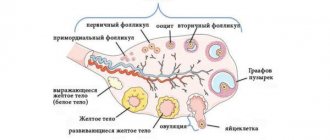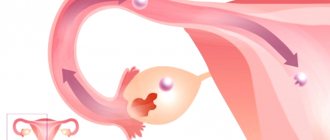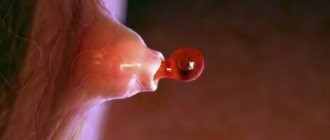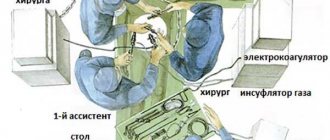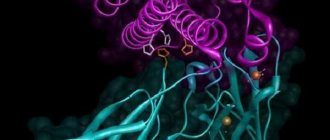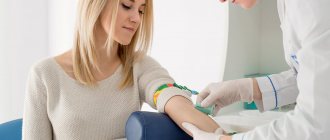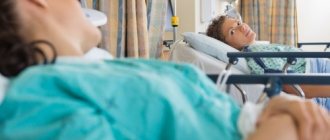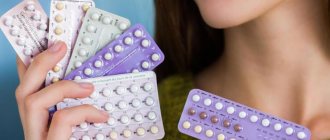How long does it take for a woman to ovulate? This is one of the most common questions asked by women planning a pregnancy. In the article below we will try to answer this question.
What is ovulation?
Ovulation is the release of a mature egg from the ovary. It moves through the tubes towards the uterine cavity. If at this moment a meeting with a sperm occurs, then conception occurs. The egg lives no more than 36 hours. If conception does not occur, the woman begins menstruation after some time.
What determines the duration of ovulation?
Since the female reproductive cell does not live very long, it is more correct to talk not about the duration of ovulation, but about the duration of the ovulatory period. This is the period of time when a woman can become pregnant. Since sperm can stay in a woman’s body for up to a week, the favorable time period for conception is 5 days before ovulation and 2 days after. It is for this reason that the week in the middle of the cycle is considered very good for conception.
The length of this period may depend on many factors.
- Cycle duration
- Physical activity
- Nervous tension and stress
- Gynecological diseases
- Taking hormonal pills.
When does ovulation occur?
With a standard 28-day cycle, the egg is released on the 14th day of the cycle. Remember that the first day of the cycle is the first day of menstruation. Of course, this is an average figure. The shorter the cycle, the earlier ovulation occurs. And vice versa - with a long cycle, the egg will be released later. For example, with a 30-day cycle, ovulation will occur on the 17th day of the cycle. With a 25-day cycle, the egg is released on the 11th day.
Unfortunately, for many reasons, ovulation may not occur at all. The main enemy of the entire reproductive system is stress. Nervous work may well cause the ovaries to fade away.
What happens during conception after ovulation?
When a female reproductive cell is fertilized, it fuses with a sperm. This zygote can then travel for several more days until implantation occurs. This is the introduction of the future embryo into the uterine mucosa. There the zygote begins its development. As soon as this happens, pregnancy can be considered to have occurred.
Symptoms of ovulation.
How to find out when ovulation occurs? It's best to listen to your feelings. There are several signs by which you can recognize the release of an egg from the ovary.
- Pain in the ovary.
- Tingling in the uterus.
- Pinkish discharge.
- Vaginal discharge becomes similar to egg white.
- A woman may feel increased desire and heightened sensations.
All this can be called subjective signs. But how to accurately determine ovulation?
Methods for determining ovulation.
So, you can determine when the egg will be released from the ovary both at home and with a doctor. Home methods include the use of tests and measuring basal temperature.
Tests. You can buy special tests at the pharmacy that detect increased levels of luteinizing hormone. The simplest option is test strips, which are inexpensive. However, they also have a disadvantage - they are not always reliable.
Electronic tests are currently popular. They are more expensive, but they can be used more than once, and they are much more reliable. In the future, you will only need to purchase urine indicator strips, which are cheap. You can carry this test with you in your purse and use it at any convenient time.
Another type of test is one that determines ovulation using saliva. Due to an increase in the level of progesterone and estrogen, a woman's saliva thickens and forms a pattern on the microscope glass that looks like fern leaves. Such tests can be called the most expensive.
Measuring basal temperature. To determine ovulation by basal temperature, you will need to keep a temperature chart for at least a couple of months. This is done like this: early in the morning, at the same time, you need to measure the temperature in the anus. This must be done without getting out of bed. The testimony must be recorded. Before ovulation, the temperature graph makes a noticeable jump. After an increase in basal body temperature, the most favorable period can be called the day after.
This technique is quite reliable, but inconvenient. Several hours before the measurement you should not get up, in addition, you must not forget to immediately take your temperature upon waking up. However, if maintained correctly, such a schedule is very convenient.
The medical method is to use ultrasound. This study is called folliculometry and will allow you to accurately determine the time of release of the egg. A few days after the end of menstruation, the doctor will perform an examination with a vaginal sensor. The procedure is then repeated after a few days. The day before ovulation, the doctor will warn you about its occurrence.
By the way, nervous stress can lead not only to a lack of ovulation, but also to the opposite result - not one egg will be released from the ovary, but two or even three. The same effect can be achieved by using hormonal contraceptives.
https://youtu.be/N4q33TQ1Uik
When does the egg release?
It doesn't take much knowledge to time this period. To do this, use the following methods:
- changes in basal temperature;
- calculation according to the menstrual cycle calendar;
- assessment of cervical mucus.
To find out what day ovulation occurs, women often use a calendar. The period when the egg is released falls in the middle of the menstrual cycle. First, the cycle duration is determined. To do this, you will need to know the first days when your period began. To more accurately find out the date of release of the egg, use data for the last 6 menstruation. You need to remember the shortest and longest menstrual cycle. The resulting numbers are subtracted from 18 from the first, and 11 from the second. For example, the short cycle lasted 28 days, and the long cycle lasted 32 days. In this case, it is worth performing the following operations:
- 28-18=10;
- 32-11=21.
From this it follows that it is most likely to conceive a child from 10 to 21 days of the menstrual cycle. During this period, the egg is released and fertilization can occur. It is determined on what days ovulation occurs in women using another method. This requires measuring your basal temperature every month. This method shows good results. A woman should take her temperature rectally. It is about 36.9 degrees. The day before the release of the egg, it decreases significantly, and then sharply rises to 37 degrees. She maintains these indicators until the end of the menstrual cycle. On that day, when the temperature rose sharply, an egg was released from the ovaries. The measurement procedure must be carried out in the morning, without getting out of bed. In this case, the woman should be in a calm state.
Ovulation stimulation
What to do if there is no ovulation? In this case, the doctor decides to stimulate the woman’s ovaries. One of the simplest methods is to take hormonal contraceptives for about three months. The ovary goes into hibernation, and then begins to work with redoubled force. Unfortunately, sometimes this method may not work.
In this case, the doctor prescribes more serious hormonal medications and injections. During the period of stimulation, some side effects may occur - increased appetite, tearfulness, irritability. To carry out stimulation, you need to undergo a series of studies.
- Complete blood count, blood tests for sugar, blood clotting, as well as HIV, hepatitis and syphilis. Both partners undergo tests.
- Study of thyroid function.
- Swabs from the genital tract for the presence of STDs. Both partners also rent.
- Breast ultrasound
- Oncological analysis of scrapings from the cervix.
- Tubal patency test
- Study of male sperm viability.
- Examination of the uterine cavity for inflammation.
Before stimulation, it is imperative to tell the doctor about all previous diseases.
How to prepare the body for stimulation.
Preparation for stimulation consists of carrying out all the necessary studies. However, it is worth preparing the body a little for such an intervention.
First of all, you should improve your nutrition. The menu should be balanced. It is necessary to completely eliminate alcohol and cigarettes. Reduce consumption of sweet, spicy, fatty and smoked foods. You should add as many fresh fruits, vegetables, and dairy products to your diet. You need to drink a lot of water.
Ovulatory process
A woman is deprived of the opportunity to conceive a child any day she wants. This opportunity is available to men who are always ready for fertilization thanks to constant spermatogenesis - the process of production and renewal of germ cells in quantities exceeding tens of millions per milliliter of sperm. Women, in order to conceive a baby, need to wait for the maturation of one single reproductive cell of their own. Its maturation occurs once a month, and the process of a mature cell leaving the follicle on the surface of the ovary is called ovulation. Conception is possible only during the period while the released oocyte lives.
After a woman completes her next menstruation, several antral follicles with immature oocytes inside begin to grow in the ovaries. But already a week after menstruation, the development of most of them stops, and one (rarely two) dominant follicle remains, inside of which an egg lives in the nutrient fluid, which also needs time to mature. An immature cell is not capable of fusion with a sperm.
The ovulation process is regulated by hormones. The follicle grows due to the action of the hormone FSH. And by the middle of the cycle, its shells become thin, a stigma forms on them, and on the right day a rupture occurs. This is facilitated by estrogen and luteinizing hormone, which peak the day before ovulation.
The egg leaves the vesicle-follicle, which was its refuge, and enters the abdominal cavity. It is immediately captured by the fallopian tube closest to it and, with rhythmic contractions of its own muscles, directs the germ cell to the ampullary part, where the fusion of gametes and the exchange of genetic information should take place.
After the follicle bursts, its place on the surface of the gonad is taken by a new formation - the corpus luteum, which is essentially a gland and is responsible for the production of progesterone, which forms the background of the second half of the female cycle. This active substance, which is usually considered the pregnancy hormone, is also produced in those in whom fertilization has not occurred, but in such a situation, after 10-13 days, the corpus luteum, going through several stages of development, ceases to exist and produce progesterone.
Estrogen comes first again and after 1-2 days menstruation begins, after which the cycle repeats again.
- Menstruation
- Ovulation
- High probability of conception
Ovulation occurs 14 days before the start of the menstrual cycle (with a 28-day cycle - on the 14th day). Deviation from the average value occurs frequently, so the calculation is approximate.
Also, together with the calendar method, you can measure basal temperature, examine cervical mucus, use special tests or mini-microscopes, take tests for FSH, LH, estrogens and progesterone.
You can definitely determine the day of ovulation using folliculometry (ultrasound).
- Losos, Jonathan B.; Raven, Peter H.; Johnson, George B.; Singer, Susan R. Biology. New York: McGraw-Hill. pp. 1207-1209.
- Campbell NA, Reece JB, Urry LA ea Biology. 9th ed. - Benjamin Cummings, 2011. - p. 1263
- Tkachenko B. I., Brin V. B., Zakharov Yu. M., Nedospasov V. O., Pyatin V. F. Human physiology. Compendium / Ed. B. I. Tkachenko. - M.: GEOTAR-Media, 2009. - 496 p.
- https://ru.wikipedia.org/wiki/Ovulation
Dates of onset
Knowing that conception is possible only when a woman has a living and active reproductive cell in the fallopian tube, it is not difficult to understand that she is capable of procreation only during the ovulatory period. When does it come?
The egg maturation processes we described above occur during the follicular phase of the female cycle. It lasts differently for everyone, since it is very dependent on hormonal levels, health status, the woman’s age and a host of other factors that can affect the shift in the day of ovulation, both up and down.
Medical publications and official sources claim that ovulation occurs in the middle of the cycle, and it would be more correct to count from the other side - not from the beginning, but from the end of the cycle, subtracting 14 days from the total duration of the cycle.
This number is fully explained and justified. If in women the first half of the cycle is not stable and can vary in duration, then the second phase of the cycle, the period after ovulation, which occurs under the influence of progesterone, usually lasts a completely standard 14 days. The error is small - no more than a day, plus or minus.
In the second half of the cycle, the influence of external and internal factors on hormonal levels is minimized, which is why in women with cycles of different durations, the second phase (luteal) almost always lasts the same number of days - 14.
Knowing this, you can calculate the estimated day of ovulation. With a 28-day cycle, the moment of release of the oocyte should be expected on the 14th day, with a 30-day cycle - on the 16th day, and so on.
Of course, in practice, the important day can shift, and this depends on the length of the first phase. It can be early or late, and there is no guarantee that the egg will mature and leave the follicle in the current cycle.
Cycles without ovulation are called anovulatory, and normally this phenomenon occurs in healthy women several times a year. With age, the number of “empty” cycles increases, which explains why it can be difficult for a completely healthy woman to get pregnant after 36-38 years.
A shift in the day of ovulation is possible due to hormonal imbalance, various endocrine diseases, disruption of the adrenal glands, thyroid gland, certain neoplasms, ovarian pathology, as well as due to an unbalanced diet, sudden weight loss or weight gain, strong feelings and stress, or previous influenza or ARVI.
The cycle also shifts in the case of travel in which a woman has experienced a disruption in internal biological rhythms when changing time or climate zones. Insufficient night sleep, working in hazardous industries, excessive physical activity and even irregular sex life - this is not the most complete list of reasons why the day of ovulation itself may occur earlier or later than the calculated date.
Let's continue self-knowledge by measuring basal temperature
Basal is the temperature measured, usually in the rectum, in the morning, without getting out of bed, at the same time. Today we can argue with the long-established opinion, which is often found in the medical literature, that basal temperature should be measured only with a mercury thermometer. A good electronic thermometer gives the same reliable data as a mercury thermometer, only much faster and safer.
Just 15 years ago, women who measured their basal temperature had to draw graphs on notebook sheets, entering measurement data into them daily. Today on the Internet you can not only use graphics, but also find programs that allow you to turn measuring your basal temperature from a boring daily activity into an exciting process of self-knowledge. You just need to enter measurement data daily, and the program itself will build a graph, determine when ovulation occurs and whether it occurred in the current cycle, provide information on whether the cycle is biphasic and how normal the duration of the second phase is, and even report on a possible pregnancy.
In the first half of the cycle, the basal temperature should be below 37 degrees Celsius, and in the second, as a rule, it is 37.0-37.3 degrees. In the middle of the cycle, on the eve of the increase, the temperature drops noticeably, and then there is a sharp increase of 0.3-0.6 degrees. The lowest point before the temperature jump will be the day of ovulation. This is how you can describe in words the ideal basal temperature schedule. However, do not be upset if it is far from perfect. For example, even with ovulation occurring, there may not be a sharp temperature jump, and on a two-phase graph, the temperature in the second phase may not rise above 36.9 degrees. This means that the method of measuring basal temperature would not hurt to be supplemented with other, more accurate studies.
Duration - features
Knowing the sequence of phases of the female cycle and methods for determining the day of ovulation, you can move on to the main question - how long does it last? In search of an answer to this question, women can find a lot of information, and not all of it is true. So, the statement that ovulation lasts 3-4 days is erroneous. In fact, the duration of ovulation is limited to shorter periods.
The ovulation process begins with the rupture of the follicle in the stigma area on its membrane. The exit occurs in a few minutes. Along with the rupture process, which may require additional time, it is generally accepted that the ovary ovulates within 1 hour. This is the maximum time during which the membrane ruptures and the egg and free fluid exit the vesicle into the abdominal cavity. This hour also includes the capture of the oocyte by the fallopian tube.
Thus, within an hour after being released from the follicle, the oocyte is in full combat readiness. And this is the answer to the question of how long a woman’s ovulation usually lasts.
As for the ovulatory period, it is limited by the lifespan of the egg. According to various sources, a mature oocyte lives after release from 24 to 36 hours. Most often - a day. Rarely - 36 hours or less than a day. During this time, the reproductive cell is either fertilized or dies.
Upon fertilization, the zygote stage begins, and the embryo travels to the uterine cavity through the fallopian tubes to be implanted into the uterine wall approximately 7-8 days after ovulation. If within 24-36 hours the oocyte does not come into contact with a sperm that is active and mobile, capable of fusion and exchange of DNA information, pregnancy does not occur. The dead egg is again released into the uterine cavity, where it floats freely until the hormonal levels change, and then leaves it along with endometrial particles and menstrual bleeding.
Conclusion: ovulation lasts no more than an hour, and the ovulation period lasts about a day (24-36 hours). There can be no other options. Although some sources claim that an egg can live longer, this has not been proven by science and medicine.
Theoretically, a woman’s bad habits, violation of the rules of a healthy lifestyle, genetic predisposition, excess weight, and some diseases of the reproductive system can shorten the lifespan of an egg. In this case, the quality of the oocyte usually suffers, and conception does not always occur, even if the egg meets the sperm.
Modern medical science, unfortunately, cannot make the oocyte live longer, up to 2-3 days. There are no such medicines or recommendations. A woman’s gamete exists exactly as long as nature has allocated for it, and not an hour more.
When to start conceiving?
Considering that a woman has a very short period of time to conceive a baby, nature has wisely provided for a longer life span for male reproductive cells. And this is a real gift to humanity, helping it to reproduce and not die out.
Sperm are very mobile, unlike the oocyte, they can quite quickly cover the distance between the vagina and the ampullary part of the fallopian tube, it takes them about 40 minutes. Therefore, conception is most likely if partners have unprotected sexual intercourse on the day of ovulation and within 24 hours after it.
Also, sperm, due to their ability to live long, can fertilize the female reproductive cell immediately after it leaves the follicle. But in this case they should already be in the genital tract. Considering that the average lifespan of sperm is 3-4 days, 4 days before ovulation are considered favorable for those planning a pregnancy.
Important! The process of conception itself, the fusion of germ cells, occurs only during the ovulatory period. And the days before ovulation are not suitable for conception, but they are suitable for creating a “reserve” of sperm in the woman’s genital tract in order to increase the chances of conception in the current cycle.
The days during which sexual intercourse can lead to pregnancy are considered the fertile window. It begins 4 days before expected ovulation and ends 2-3 days after it ends. If the day of ovulation shifts, the boundaries of the fertile window shift along with it.
Thus, a woman needs to begin actively planning for conception even before the oocyte leaves the follicle. With a 28-day cycle, the fertile window “opens” on the 10th day of the cycle, with a 30-day cycle – on the 12th day, and so on.
How does the cycle work?
- A new cycle starts on the first day of menstruation. At this time, follicles begin to develop in the ovaries (this is the follicular, menstrual phase).
- From the seventh day until the middle of the cycle, the ovulatory phase occurs. The maturation of the egg occurs in the follicle.
- In the middle of the cycle (relatively on the 14th day of a 28-day cycle), the follicle ruptures and ovulation occurs. The egg then moves through the fallopian tube to the uterus, where it remains active for another 1-2 days. It is important to understand that the length of the menstrual cycle varies from woman to woman, but the length of the ovulatory period is almost the same (12–48 hours). How many hours ovulation lasts is purely individual. Most doctors believe that the egg retains the ability to fertilize within 24 hours.
- One or two days after ovulation and before the start of the next menstruation, the corpus luteum phase begins (this is the same follicle, only now modified).
- If the egg has been successfully fertilized, after three or four days it should enter the uterine cavity, and after another one or two days it should attach to its wall. After implantation, a period of active development begins and pregnancy comes into its own. If conception does not occur in this menstrual cycle, about a day after leaving the follicle the egg dies, which, in turn, causes the start of a new cycle and menstruation within two to two and a half weeks.
Debunking the Myths
Ovulation is shrouded in a mass of myths that prevent a normal understanding of the process, and sometimes even the fruitful conception of offspring. Let's dispel common misconceptions that a modern woman definitely needs to know about.
Women with short cycles ovulate longer
This is wrong. The duration of the cycle is an individual feature of the female body, as is the duration of menstruation itself. But the duration of the ovulation period and ovulation itself is the most stable criterion, which does not depend on how many days the cycle lasts for a representative of the fair sex.
Therefore, both with a cycle of 24 days and with a cycle of 35 days, ovulation lasts no more than an hour, and the ovulatory period lasts about a day and a half, since the lifespan of the oocyte is not affected by the length of the cycle.
How to determine?
Ovulation is the maturation and release of an egg. At this moment, the woman’s body is ready for conception. When having sexual intercourse with a man, there is every chance of fertilization.
In other words, these are the few days in the middle of the menstrual cycle when a woman of reproductive age has the opportunity to become pregnant.
When planning a child, it is important to know not only how to determine favorable days, but also when ovulation begins and how many days it lasts.
There is a standard way of calculating: this is approximately two weeks before the start of menstruation. However, much depends on the duration of the cycle and its regularity. This method of determination is more suitable for women with a 28-day regular cycle. For those whose cycle exceeds 28 days and is 35 days, for example, the period before the release of the egg increases accordingly.
If you have an irregular cycle, other ways can help:
When the egg matures, a serious hormonal change occurs in the female body. As a result, the amount of hormones in the blood changes, as well as basal temperature (BT). Measuring it daily and charting it allows you to accurately determine the days suitable for conception.
The highest accuracy in determining days favorable for conception is using a test and ultrasound procedure. However, they are more expensive in contrast to drawing up a BT schedule.
Basal temperature chart during ovulation
Algorithm for calculating the day of ovulation
Understanding the process of ovulation, you should know that it occurs almost in the middle of the female cycle - between the follicular and luteal processes. The first is characterized by the maturation of a germ cell in the ovary and can last on average from 11 days. The second is static and always lasts 14 days, and ends with bleeding of the next menstruation. Between them there is a short period of time (1-1.5 days), which is called ovulation.
The increase in the chance of fertilization at this moment is explained by the fact that the cell left the ovary and entered the fallopian tubes. If the effect is successful, the sperm will reach it here, and once fertilized, it will attach to the wall of the uterus.
Knowing these simple facts, it is very easy to determine on what day ovulation occurs after menstruation. It is enough to subtract the constant value 14 (luteal phase) from the cycle duration. The resulting number indicates how much you need to count from the beginning of menstruation.
Following this rule, we obtain the following values:
- On the 12th day, with a cycle of 26.
- 13th – 27;
- 14th – 28;
- 15th – 29;
- etc.
How long does ovulation last?
To successfully plan a pregnancy, you should know how long ovulation lasts in women. This period accounts for about 16-32 hours.
Indicate the numbers more precisely, how long ovulation lasts. Everything here is individual. And it is worth noting that 16-32 hours is the preparation period, and the rupture of the follicle and the release of the finished egg occurs in a matter of minutes.
In addition to using special detection methods, a woman can feel it based on characteristic signs if she listens carefully to her body.
The symptoms are as follows:
- noticeable increase in sexual desire;
- pain in the lower abdomen (more on the left or right, depending on in which ovary the egg matures);
- transparent mucous discharge (streaks of blood may appear).
No less important is the question of how many hours the egg lives. Her life span and fertilization ability range from 12 to 48 hours. Then it is either fertilized in the presence of sperm, or comes out with menstrual blood. After mucus, cessation of vaginal discharge and other symptoms, we can talk about the cessation of ovulation.
What does it depend on?
The presence of regular maturation of a female cell, once per menstrual cycle, indicates the reproductive health of the girl and her ability to become pregnant.
A variant of the norm is the absence of maturation of a female cell for one month a year or the maturation of two eggs in one menstrual cycle.
A number of factors influence how many days ovulation takes place in a 28-day cycle or with a longer cycle:
- hormonal balance in a woman’s body;
- taking hormonal contraception;
- antibacterial therapy;
- bad habits;
- way of life in general.
Changes in the process of maturation of the reproductive cell or its absence are possible after artificial termination of pregnancy, after childbirth, as well as upon the onset of premenopause.
If there is no ovulation for several cycles, you need to visit a doctor and undergo an examination. Non-ripening of the egg may indicate the presence of hormonal or gynecological problems.
How to do an ovulation test? Read the article about the operation of the device and the time of its implementation, types of ovulation tests, instructions for use and possible reasons for a negative result.
What drugs are used to stimulate ovulation? Details here.
What is ovulation?
A woman's ovaries contain about 1 million eggs from birth, and with each cycle, one or more eggs from this huge supply mature and become ready for fertilization. The moment a mature egg is released from the ovary is called ovulation. This process is a prerequisite for conception. If there is no ovulation, then there is no egg ready for conception. That is why the presence of ovulation in a woman is the first and necessary condition when planning pregnancy.
Many people confuse two concepts: ovulation
and conception. In fact, these are two different processes that occur in a woman’s body. Ovulation occurs first, and within 24 hours after ovulation, conception can occur.
Early and late maturation of the egg
Early ovulation is characterized by the release of a female cell, ready for fertilization, 7-9 days after menstruation.
Late occurs approximately 10 or 8 days before the start of menstruation.
In some cases, early or late maturation of the female reproductive cell is not a deviation from the norm. The reasons vary from person to person and may include the following:
- infectious diseases;
- chronic diseases;
- stressful situations;
- diets;
- hormonal disbalance;
- excessive physical activity or lack thereof.
The question about the duration and period of maturation of the reproductive cell, the possibility of conception, is often asked by young women in order to become pregnant. The maturation of the egg is considered an important indicator of the female body’s ability to reproduce. To achieve successful conception, a woman needs to determine the onset of ovulation and its duration.
https://youtu.be/-C3ib1y_6bI
